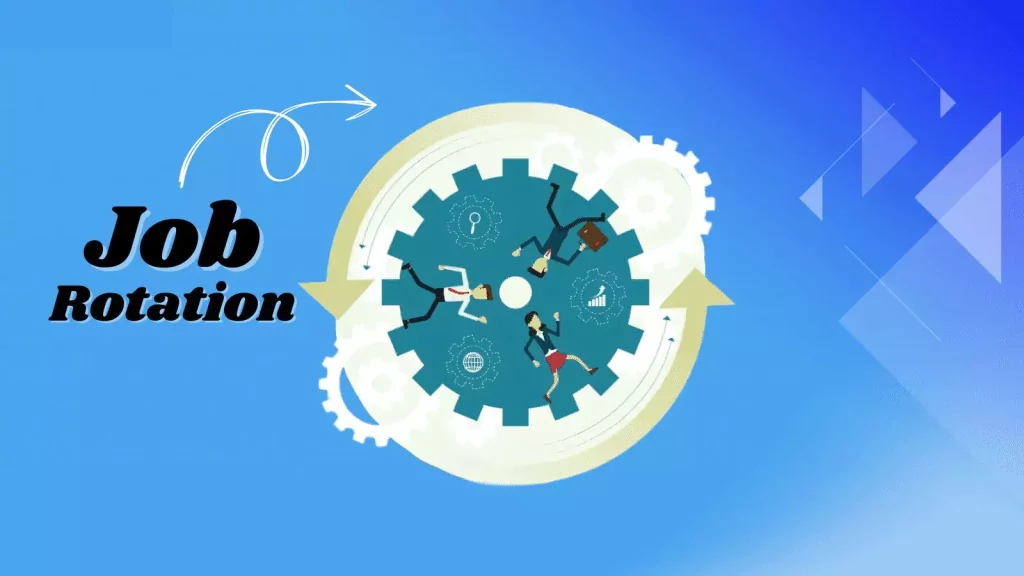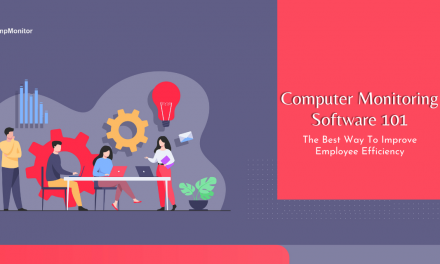Businesses continually seek innovative strategies to keep employees motivated and engaged. One such effective strategy is job rotation. By allowing employees to rotate through different roles within the organization.
It enhances their skills and knowledge and boosts job satisfaction and productivity. This approach fosters a versatile workforce ready to adapt to various tasks and challenges.
This blog explores the concept of role rotation, its advantages for employee development and company efficiency, and practical strategies for successful implementation.
Let’s discover how work rotation can transform your workforce and elevate your business operations.
IN A HURRY? LISTEN TO THE BLOG INSTEAD!
Job Rotation Definition
Job rotation involves systematically moving employees between different organizational roles or departments according to a planned work schedule. This practice aims to provide employees with various experiences and skills, reduce boredom, enhance job satisfaction, and improve overall organizational flexibility by ensuring that multiple employees can perform various roles effectively.
Objectives Of Job Rotation
Job rotation serves several key objectives within an organization:
Reducing Job Monotony: It aims to alleviate the monotony and repetition that can arise in a single role by exposing employees to different types of jobs. This variety motivates them to perform effectively in each new role they undertake.
Succession Planning: It contributes to succession planning by cultivating a pool of employees capable of stepping into senior positions when needed due to retirement or departure. It ensures continuity and reduces disruptions in organizational leadership.
Enhancing Employee Job Fit: Ensuring that employees are placed- in roles that align with their skills and strengths is critical for organizational success. Job rotation facilitates the identification of the right fit between employees and roles, thereby optimizing productivity and job satisfaction.
Exposure To Various Company Verticals: By rotating employees through different departments or operations, task rotation familiarizes them with the organization’s structure and processes. This exposure enhances their understanding of company operations and the challenges faced across different functions.
Assessing And Developing Skills: It enables organizations to assess and develop employees’ skills and competencies by placing them in diverse roles. This process helps identify areas of proficiency and aptitude, ultimately improving on-the-job performance.
Broadening Work Experience: Encouraging employees to step out of their comfort zones and gain experience in various roles promotes personal and professional growth. It equips them with a broader range of- skills and perspectives, contributing to their overall development.
Job rotation is a strategic management practice that benefits employees and management by fostering skill development, organizational flexibility, and employee engagement.
Pros Of Job Rotation
Employee rotation programs are increasingly adopted- by companies for their mutual benefits:
Increased Employee Experience: Task rotation helps employees gain knowledge across different company areas, fostering a holistic understanding that connects various aspects of the organization. For instance, a marketing employee gaining experience in sales can enhance their effectiveness in their current role.
Enhanced Employee Motivation and Satisfaction: Research shows that staff rotation boosts employee motivation by allowing them to develop skills and competencies in diverse roles. This motivation leads to improved- job performance and overall satisfaction, benefiting employees and the company.
Reduced Resignation Rates: Work rotation positively impacts job satisfaction and career development, reducing turnover rates. Employees value the variety and opportunities for growth, which enhance their commitment to the organization.
Increased Workforce Flexibility: Training employees in multiple roles creates a more adaptable workforce. This flexibility ensures that the organization can swiftly fill positions as needed, minimizing disruptions.
With the help of employee monitoring software like EmpMonitor, you can assist in this process by tracking employee activities and productivity. Using features such as real-time monitoring and detailed reporting, EmpMonitor helps managers identify employees’ strengths and areas for improvement, facilitating targeted training and role allocation.
Try Now!
Improved Employee Engagement: Task rotation programs significantly improve employee engagement by introducing variety and preventing monotony. These programs keep employees connected and motivated by exposing employees to different tasks and responsibilities. workforce management software like EmpMonitor supports this process by offering detailed reports and analytics on employee productivity, ensuring that rotations effectively boost engagement and motivation.
Optimized Job Placement: By rotating employees into various positions, managers gain insights into their skills and strengths, enabling better job placements that maximize productivity and contribution to the company. Streamline candidate screening for rotation cohorts with Apply IQ, which scores and ranks applicants based on skills and experience so managers can match people to roles faster.
Effective Succession Planning: Rotation builds a pool of capable employees prepared to step into key roles when necessary, ensuring continuity and operational stability during transitions.
Job rotation is a strategic method that boosts employee retention and organizational effectiveness by cultivating versatile employees who are motivated, engaged, and ready to face future challenges. Utilizing tools like EmpMonitor can further enhance this process by providing detailed insights into employee productivity and workflow.
EmpMonitor: Workforce Management Software
EmpMonitor revolutionizes workplace oversight by providing organizations with powerful insights into employee activities. This cutting-edge software ensures employers can monitor and analyze real-time data on productivity and behavior, enabling them to foster a productive and compliant work environment effectively.
- Activity Monitoring: Tracks time spent on applications and websites, providing a detailed breakdown of how employees utilize their work hours.
- Productivity Analysis: Generates productivity reports based on active and idle time, helping managers identify trends and make informed decisions.
- Screenshots And Screen Recording: Takes screenshots at predefined intervals or records screens to monitor employee activities visually.
- Website And App Usage Tracking: Monitors which websites and applications employees access, helping to identify potential distractions or security risks.
- Data Security: Ensures data privacy and security with encrypted logs and restricted access to sensitive information.
- Insightful Reports: Visualize employee engagement and perform flawless team analysis with graphic-rich analytical reports and automated timesheets, ensuring comprehensive insights and efficient monitoring of team performance.
EmpMonitor is suitable for businesses of all sizes- looking to enhance productivity, streamline operations, and maintain accountability among their workforce. It offers a comprehensive suite of performance monitoring tools while maintaining a balance between employee privacy and regulatory compliance.
Cons Of Job Rotation
While job rotation brings advantages, businesses should also weigh potential drawbacks.
Cost In Time And Resources: Constantly rotating employees requires frequent training, impacting productivity and potentially affecting company profitability. Learning new roles may also lead to work interruptions as employees adjust to their new responsibilities.
Employee Dissatisfaction: Some employees may feel uncomfortable or dissatisfied when moved from their familiar roles, especially if they have invested time in mastering their current position. This change can disrupt workflow and affect morale, potentially resulting in decreased motivation or even turnover.
Limited Career Advancement Opportunities: Task rotation typically involves lateral moves rather than promotions. While it broadens employees’ skills, it may not provide clear paths for career progression to higher levels- within the organization. It could be perceived- as a barrier for employees aspiring to advance in their careers.
4 Types Of Job Rotation
Here are the Four types of job rotation:
Horizontal Rotation:
Employees transition between various roles or positions within the same hierarchical level or department. It helps broaden their skills and understanding within a specific functional area. For example, a marketing executive temporarily takes on a sales role to gain insights into customer needs.
Vertical Rotation:
Employees are rotated- to positions at different hierarchical levels within the organization. It allows them to gain a broader understanding of different levels of responsibility and develop leadership capabilities. For instance, a junior manager is promoted to a higher-level managerial role to enhance their leadership skills.
Lateral Rotation:
Employees are rotated across different departments or functional areas. This rotation type promotes cross-functional experience and a holistic view of the organization’s operations. For example, a software developer moves to quality assurance to learn about testing processes and improve product quality.
Geographical Rotation:
Employees are relocated to different locations or regions to gain exposure to diverse markets and operational environments. This rotation enhances their global perspective and allows them to contribute effectively to global strategies.
Example Of Job Rotation
Here are some examples of job rotation programs in leading companies across different career areas like HR, finance, IT, and business operation:
Microsoft
Microsoft Aspire is a two-year rotational program aimed at helping recent graduates gain insights into the company, expand their network, and discover how their strengths and interests align with various job opportunities within Microsoft. The program offers one track for recent college graduates and another for individuals who have recently completed an MBA.
Additionally, students enrolled in a Master of Human Resources or MBA program can join Microsoft’s HR Rotation program, which includes a 12-week internship followed by a three-year rotational program designed to accelerate their HR career.
Deloitte
Deloitte’s SHINE program is designed for recent college graduates with degrees in marketing or communications. This rotational program places participants in several three-month rotations within the client and market growth team.
Associates gain experience in diverse marketing projects such as social media campaigns, business expansion support, and the creation of promotional marketing and sales tools. Additionally, they benefit from educational sessions, workshops, and Q&A sessions with Deloitte’s marketing and communications professionals.
Abbot
Abbott employees can rotate jobs in six focus areas: clinical, finance, information technology, and operations. Selected participants commit to a two- to three-year assignment, rotating through various tasks, disciplines, and office locations nationwide.
This program allows new graduates to experience multiple roles quickly, helping them explore their interests and preferences.
GE
GE provides rotational leadership programs for recent graduates in areas such as operations management, digital technology, financial management, and more. These two-year programs include rotational assignments, coaching, and opportunities to interact with company leadership. For instance, the HR leadership program rotates employees through three actual HR roles, each for eight months.
Siemens – Automation And Manufacturing Company
Siemens Nederland introduced a job rotation program in 2005, applicable across all divisions and functional levels for employees of all ages. A contractual stipulation limits the time employees can spend in a single job, requiring them to periodically reassess their preferences and needs.
According to Siemens’ HR director, work rotation is vital at all career stages, but older employees must prevent them from being pre-selected for less challenging tasks as they approach retirement.
ALSO READ:
06 Best Ways To Improve Employee Retention | Empmonitor
How To Create An Effective Work Schedule: 09 Easy Steps
Job Rotation Best Practices
Implementing job rotation requires careful planning and consideration of several important factors. Here are some best practices to ensure successful job rotation:
1. Clear Goals And Time Frame:
- Define the purpose and objectives of the role rotation program clearly from the outset.
- Set a timeframe for each rotation so employees know how long it will last and what is expected.
2. Preparation And Training:
- Ensure employees are adequately prepared before their rotation begins.
- Provide training and resources related to the new role to enhance readiness and minimize learning curves.
- Assign mentors who can support employees during their rotational assignments, offering guidance and answering questions.
3. Create A Plan And Document Processes:
- Develop a structured plan for each rotational role, outlining key responsibilities, skills to be acquired, and learning objectives.
- Document processes and procedures for each position to facilitate training and ensure consistency in operations.
4. Timing Of Rotation:
- Plan rotations during periods of lower activity or during off-peak seasons to minimize disruption to regular operations.
- Avoid rotating employees during critical periods when high productivity and focus are crucial.
5. Alignment With Career Paths:
- Align task rotations with employees’ career aspirations and development objectives.
- Design rotations that contribute to building skills relevant to their career trajectory and future roles within the organization.
6. Establish Measurable Objectives:
- Establish clear and measurable objectives for every rotational assignment.
- Set goals that align with both organizational needs and employee development, allowing for progress tracking and performance evaluation.
7. Collect And Act On Feedback:
- Encourage feedback from participants, mentors, and managers involved in the task rotation program.
- Use feedback to refine and improve the rotation process, address challenges, and enhance the overall effectiveness of the program.
- Give regular feedback to employees on their performance and progress during rotations to aid their development and career growth.
By adhering to these best practices, organizations can successfully implement job rotation programs that enhance employee skills, foster career development, and contribute to organizational success.
Wrapping Up
Job rotation is a versatile strategy in modern workplaces. It helps employees learn new skills, stay engaged, and avoid burnout, benefiting both their careers and the organization’s productivity.
Employee management Tools like EmpMonitor provide insights into productivity and distractions, making task rotation even more effective for nurturing talent, improving workflows, and fostering a dynamic workplace culture. By integrating work rotation with tools like EmpMonitor- businesses can thrive in today’s competitive environment.
FAQs
Q. Why is job rotation important?
Taking on a new role entails acquiring and mastering new skills. Job rotations encourage career development, help employees upskill, and enhance your talent pool’s overall quality. Additionally, they often boost employees’ confidence in their roles and increase their overall understanding of the company.
Q. What is a real example of job rotation?
A hospital has different departments and job rotation is more common in the nursing department. Nurses are encouraged to work in various departments, from the emergency room to the psychiatric wards.
Q. What is the main strength of job rotation?
It increases motivation. Job rotation boosts motivation and reduces boredom. It encourages all employees, helping them tackle new challenges and enhancing satisfaction.
















